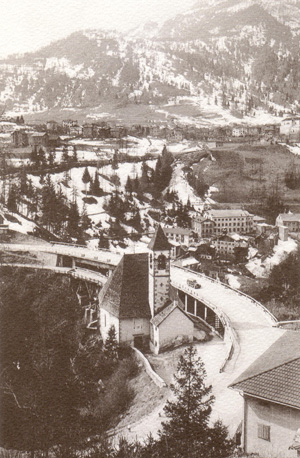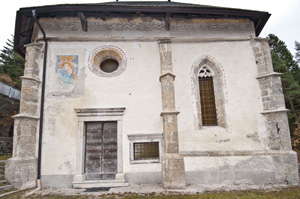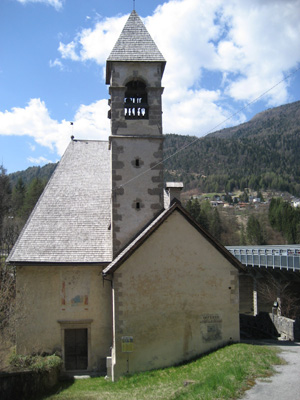| Card n. | Description | Locality | Linked sites |
| 14 | Church of the Madonna della Molinà | Domegge di Cadore | 153 - 136 |
| file .pdf | Architecture Art History (ASA) | Google maps |
 |
 |
 |
- Description
- How to get there
- Interesting facts
- Bibliography
The church è dedicated to the Madonna delle Grazie, who had protected the people of the Cadore during the invasion of the imperial troops in the War of Cambrai. It was built on a rock outcrop above the ravine of the Molinà torrent, around 1510, on top of a miraculous capital, while in 1573-80 a second nave and a hermitage were built for the Battuti confraternity. This is one of the numerous votive churches in the Cadore built by the Ruopel family, who worked for fifty years using the same stylistic characteristics: polygon-shaped apses, ribbing painted on the ceilings, keystones with figures and marks, external coping with geometric-style decorations, corner buttresses and shaped corbels. Ancient records tell us the Madonna frescoed on the main altar used to sweat and change colour, while legend has it that there was contention between the two neighbouring villages of Calalzo and Vallesella over where the church was to be built, and that in the depth of night, the building shifted from one side to the other of the torrent. According to tradition, the Madonna performed miracles on several occasions to save those who had the misfortune to fall from the gorge or the bridge above, as is testified to by a number of interesting votive offerings. The frescoes on the wall of the apse, on an altar built in marble and stone, show a Madonna with Blessing Child, which can be dated to the 15th century as a result of the style and the inscription “24 March 1476”, engraved next to the throne together with an unidentified geometric-style design containing a cross.
The church sits on the left bank of the Molinà Brook, downstream from the bridge and not far from the Calalzo railway station and the Centro Cadore Lake. It marks the border between the municipalities of Domegge and Calalzo di Cadore.
ACCESSIBLE: visible from the outside; the interior may be visited on request
MUNICIPALITY: Domegge di Cadore
PLACE: Vallesella - Molinà
GEOGRAPHICAL COORDINATES: X 1760269 – Y 5149574
PROVINCE: Belluno
FILE COMPILED BY: Lonzi
The Molinà torrent, an affluent of the Piave, takes its name from the numerous mills and workshops that once flanked it, creating a small early industrial area: the first glasses factory was built further north, also on the Molinà, at “Le Piazze” (Calalzo) in 1878; it would later be moved closer to the church, becoming the famous Safilo factory, today an interesting example of industrial architecture.
As regards the quality contemporary architectural elements built near the Centro Cadore lake, Vallesella is home to the Multiphysics Lab (136 CA), a recently built facility destined for research and technological innovation, with the future of the local area in mind. The main aim of the centre, inaugurated in 2009, is to study multiphysics as a method for optimising products and manufacturing processes. Also in Vallesella, over the Centro Cadore lake, is the first bridge in Italy to have been built using precompressed reinforced concrete, by the engineer Carlo Pradella in 1949-50.
A. Cusinato, L’arte in Cadore al tempo di Tiziano, Florence, 2008
M.S. Guzzon – A. Guzzon, Cadore. Architettura e Arte, Padua, 2008
M.F. Belli, G. Zanderigo, In Cadore al tempo di Tiziano, Pieve di Cadore, 1990

